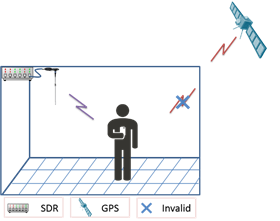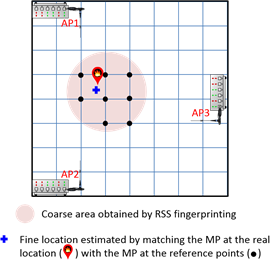Archived content
NOTE: this is an archived page and the content is likely to be out of date.
Fujitsu Develops Indoor Asynchronous Wireless Positioning Technique Based on Multipath Profile Fingerprinting and Particle Filter
Two-step fingerprinting localization enables asynchronous wireless positioning. Particle filter augmented by map matching can achieve 1-meter-level tracking accuracy.
Fujitsu Research & Development Center Co. Ltd.
Fujitsu R&D Center today announced a wireless positioning and tracking technique based on multipath profile fingerprinting and particle filter. The technique doesn’t require any synchronization among transceivers, reducing the complexity of positioning system structure. Their indoor positioning system takes advantage of multipath propagation characteristic to improve accuracy, and utilizes two-step (or called coarse-fine) positioning method to realize asynchronous wireless localization. Their tracking is based on particle filter augmented by map matching technique, and the positioning and tracking accuracy can reach up to 1-meter level performance. This technique can be easily and low-costly applied to many indoor LBS applications.
Details of this technique is also presented at the 2016 IEEE 84TH Vehicular Technology Conference: VTC2016-Fall, opening on September 21 in Montreal, Canada.
Background
The market of location based service (LBS) has been increasing dramatically in recent years. Positioning technique is one of the important parts in LBS structure. In indoor area, the positioning technique can be applied in shopping mall, museum, exhibition hall, parking lot, hospital, warehouse and so on. It can be used for the services like accurate advertising, navigation, goods management, and also used for the development of indoor virtual reality games. High-precision indoor positioning technique could enhance the quality of LBS, providing human with better digital services.
Technological Issues
In general, global positioning system (GPS) is invalid for the indoor LBS. The traditional time of arrival (TOA), time difference of arrival (TDOA) based indoor wireless positioning systems suffer from none-line-of-sight (NLOS) propagation, multipath effect and shadowing effect. In addition, these systems require the transceivers to be precisely synchronized, which results in the systems to be more complex.
About the technology
Fujitsu R&D center developed the indoor positioning prototype based on software defined radio (SDR), as shown in Figure 1. The indoor transmitter can send the reference signal of wireless network, like GPS when GPS is invalid in indoor environments. The receiver extracts the multipath profile (MP) and received signal strength (RSS) from the received signals. Then the terminal will estimate the location to realize the indoor localization technique.

Figure 1: Indoor positioning system
Key features of the technology are as follows.
1. Two-step fingerprinting localization
Fingerprinting localization includes two phase, the offline phase and online phase. In the offline phase, the database stores the fingerprint which is a set of signal metrics measured at the predefined reference points (RPs) in the target area. In the online positioning phase, the system matches the real-time measured fingerprint with that at the RPs stored in the database. The location is estimated based on the best matched RPs.
To realize asynchronous positioning, the technique first uses RSS fingerprinting to locate the target into a coarse area as shown by the pink area in Figure 2. Then the multipath profile fingerprinting gets the fine location estimation by matching the online profile with the profiles at the RPs in the coarse area. The matching between multipath profiles needs to first align the two profiles based on maximum correlation criterion, as shown in Figure 3. The similarity between two denoised profiles are calculated in terms of vector cosine value. The best matched RPs with largest similarities are finally selected to estimate the fine location.

Figure 2: Two-step fingerprinting localization

Figure 3: Multipath profile alignment and denoising
2. Particle filter based on map matching
Particle filter consists of essentially three steps: particle state prediction, weight updating, particle resampling. In this tracking system, the particle state prediction is based on a robust motion model, which assumes that the step length and heading are random variables drawn from uniform distributions. Compared with traditional method, the weight updating introduces another constraint probability via map matching. The system will find a path that closest to the last location estimation, and then the constraint probability is calculated as a function of distance between the particles and the path center. Figure 4 demonstrates the proposed particle filter model.

Figure 4: Particle filter model
Results
The technique has been tested in the office of Fujitsu R&D Center. The results show that the positioning and tracking system can reach up to 1-meter level accuracy. This technique has the following advantages.
- Reduce the complexity of system because the synchronization is unnecessary.
- Improve the accuracy by taking advantage of multipath propagation characteristic. The accuracy is increased by 38.9% in the experiments.
- Easy to realize in existing WiFi or LTE based positioning system.
Future plan
Currently, the particle filter model in this technology is only adapted for the medium/low moving speed occasions. To get high-precision tracking result in a high-speed moving occasion, Fujitsu R&D Center will focus on the solution based on fusion with inertial measurement unit (IMU). Furthermore, they will press forward the practical LBS applications in the future.
Press Release ID: 2016-09-19
Date: 19 September, 2016
City: Beijing, China
Company:
Fujitsu Research and Development Center Co., Ltd.
